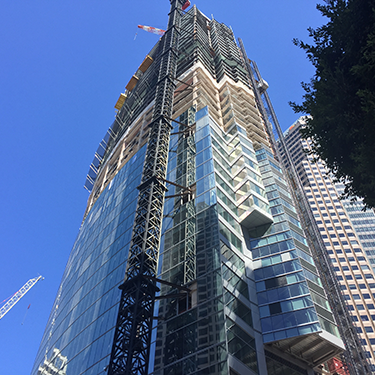 A customer observes the jerky booth at the FIG@7th Farmers Market (Helen Z.Carefoot).
A customer observes the jerky booth at the FIG@7th Farmers Market (Helen Z.Carefoot).
It’s a sunny morning in downtown Los Angeles and the streets are flooded with activity. Car horns honk as people bustle through the streets juggling strollers, coffee cups and briefcases, shielding their eyes from the sunlight bouncing off the reflective marble walls of banks and skyscrapers. This mad dash to wherever one is going is commonplace in a city like Los Angeles or New York, where people seem to wander, but only with a purpose. But recently a new breed of morning commuter has emerged amidst the legging-clad women dashing to SoulCycle and the besuited bankers about to clock in: the urban farmers market shopper. On Wednesday, Thursday and Friday mornings, shoppers break out their cloth bags and push carts before heading to three of downtown Los Angeles’ best-stocked farmers markets in Pershing Square, FIG@7th and in Bank of America Plaza.
A map of three urban farmers markets in the Financial District and Bunker Hill.Bounded by skyscrapers instead of suburban streets and shops, urban farmers markets greet wandering Angelenos with a litany of sights and smells ranging from colorful produce stacked high in wooden crates to burlap sacks of roasted peanuts glistening with salt. These aren’t the type of farmers markets that sprawl for blocks, like those found in Santa Monica or Diamond Bar. These markets are compact, with bright tents densely arranged in a ring, beckoning shoppers with bright colors and elaborate displays. Because much of the clientele is made up of urban professionals and typical operational hours range from 9 a.m. to 2 p.m., food trucks and prepared food stands hawking everything from kombucha to gyros have a larger presence to accommodate lunch break hunger pangs.
Oscar Diese, who works for Arnett Farms, is a fixture at the Pershing Square Farmers Market. Every Wednesday, he arrives at 9 a.m.on the dot to assemble his booth. He sets up the white poles and anto-fly netting quickly, but savors arranging the multicolored fruit into pleasing rows, stacks and piles.
“I like thinking about what will draw people in,” Diese said. “I like to vary the height and colors.”
A Look Inside: Arnett Farms Tent (Pershing Square Farmers Market
 Oscar Diese works the Arnett Farms tent on Wednesday mornings at the Pershing Square Farmers Market (Helen Z. Carefoot).
Oscar Diese works the Arnett Farms tent on Wednesday mornings at the Pershing Square Farmers Market (Helen Z. Carefoot).
 Diese works for Arnett Farms, which is based in Fresno, Calif.(Helen Z. Carefoot).
Diese works for Arnett Farms, which is based in Fresno, Calif.(Helen Z. Carefoot).
 Arnett Farms is known for growing more than 200 types of stone fruits,citrus and berries, Diese said. (Helen Z. Carefoot).
Arnett Farms is known for growing more than 200 types of stone fruits,citrus and berries, Diese said. (Helen Z. Carefoot).
 Diese watches soccer when the tent is slow (Helen Z. Carefoot).
Diese watches soccer when the tent is slow (Helen Z. Carefoot).
 "A lot of people buy persimmons in the winter," Diese said (Helen Z. Carefoot).
"A lot of people buy persimmons in the winter," Diese said (Helen Z. Carefoot).
 Each fruit is weighed to determine price (Helen Z. Carefoot).
Each fruit is weighed to determine price (Helen Z. Carefoot).
 Diese tries to arrange fruit differently on each market day. Today, he is using apple picking baskets to display a variety of citrus(Helen Z. Carefoot).
Diese tries to arrange fruit differently on each market day. Today, he is using apple picking baskets to display a variety of citrus(Helen Z. Carefoot).
As the day wears on, Diese goes about his routine, interacting with customers and rearranging the fruit. When business slows a bit, he checks the score of the FC Barcelona game on his phone, which is conveniently hidden behind a basket of pears. Diese’s customers know exactly what he is up to and relish in his happiness when his team scores.
Maya Baker, a downtown local who is working on a clothing line, has frequented the Arnett Farms booth for seven years. It’s clear she knows what she is doing when she peruses the lines of orange persimmons and maroon plums, lifting each sphere up carefully and lightly squeezing to test for ripeness.
“I haven’t found a bad piece yet,” Baker says as she tucks a strand of red hair behind her ear and hitches her cloth bag further up her shoulder. “I just walk here from home and I know I’ll find something good.”
“Have you tried the pears?” Diese asks Baker as he helps pile the carefully selected plums into her cloth bag. When she says she hasn’t, he drops two pears into her bag.
“She always gets a discount because she’s so loyal,” he says. “She’s my friend and I know she’ll be back next week.”
On the other side of the Pershing Square Farmers Market, Hyong Na is carefully arranging pots of delicate orchids and fortune plants. Before Na immigrated to the United States, he operated an orchid greenhouse in Korea for 11 years.
“I think orchids do well for people in the city because they’re indoor plants,” Na said. "People can manage more than one."
A petite woman strides into the tent, her sandals making noise as she crosses the small rug. Her name is Rose Yin and she comes to Na's booth regularly to buy fortune plants, which she gifts to her co-workers.
 Orchid grower Hyong Na helps a customer select a plant at the Pershing Square Farmers Market(Helen Z. Carefoot).
Orchid grower Hyong Na helps a customer select a plant at the Pershing Square Farmers Market(Helen Z. Carefoot).
It’s these types of friendships that make farmers markets community hubs. These suburban spaces provide outlets for people to enjoy food and beverages and to form connections to people they might not have crossed paths with.
Throughout history, markets and trading stations have provided places for social and monetary exchange. It's an arrangement that benefits both the supplier and consumer: farmers are able to sell their wares directly to customers, eliminating the middle men and decreasing the cost of shipping and related fees. Customers can see where their produce is coming from and can use information learned from the growers to make informed purchases.
Two organizations are almost solely responsible for the plethora of farmers markets in and around Los Angeles, Raw Inspiration and California Certified Farmers Markets. The two firms work in tandem. California Certified Farmers Markets provides the market’s vendors while Raw Inspiration oversees every aspect of the markets themselves, from assigning booth spaces for each vendor to physically setting up tents.
A representative from California Certified Farmers Markets could not be reached for comment on this story.
Marketability and social media sharing have become an integral part of connectivity. This visual mode of communication is well-suited to a farmers market, where patrons and vendors alike can communicate and share experiences. Above is a gallery of Instagram posts aggregated using the hashtag "#downtownlafarmersmarket." The gallery below shows posts hashtagged with "#figat7thfarmersmarket."Amber Tallamantes has worked for Raw Inspiration for eight months and has seen first hand what goes into planning a market.
Although the markets at Pershing Square, FIGat7th and the Bank of America Plaza are smaller than other markets Raw Inspiration manages, Tallamantes says the approach the firm takes to finding vendors for urban markets is not different than the process they use for more suburban markets.
“We operate 22 markets and constantly receive applications for vendors to participate for each location,” Tallamantes said. “I think people like opening up stands in markets because it’s small and they’re not assuming that much risk, unlike opening a restaurant or store.”
But despite the growing number of markets in the Los Angeles area, nationwide farmers market sales have declined. According to a 2015 report from the United States Department of Agriculture, "Trends in U.S. Local and Regional Food Systems," total revenue from Southern California farmers markets declined from $4.2 million in 2007 to $2.3 million in 2012, while total revenue at all markets in the United States declined by 1 percent in the same period. There are more than 200 farmers markets in Southern California today, operating between Thursday and Sunday. With so much competition in one region, it is natural that some people are looking for alternatives.

Businesses like Fresh Nation and Good Eggs are offering home delivery options for farmers market goods and Amazon is reportedly testing a new version of Amazon Pantry catering specifically to farmers market produce. Although Amazon's competitors in the grocery game are mostly warehouse clubs like Costco and larger stores like Walmart, expansion into the fresh food market could alleviate pressure from a possible oversaturation of sellers.
Christian Gallardo, a veteran seller who has weekly booths at the market at FIG@7th and the Bank of America Farmers Market, does not think online is a threat because it compromises the very thing that makes farmers markets work: human connection.
"People like going out and knowing where they are getting their food from and knowing who the actual grower or roaster is," Gallardo said. "It's also a nice environment and a lot of people make a trip and will walk around with their families looking at the strawberries. Farmers markets will always be around."


